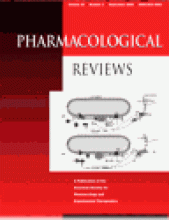Abstract
Guanylyl cyclases are a family of enzymes that catalyze the conversion of GTP to cGMP. The family comprises both membrane-bound and soluble isoforms that are expressed in nearly all cell types. They are regulated by diverse extracellular agonists that include peptide hormones, bacterial toxins, and free radicals, as well as intracellular molecules, such as calcium and adenine nucleotides. Stimulation of guanylyl cyclases and the resultant accumulation of cGMP regulates complex signaling cascades through immediate downstream effectors, including cGMP-dependent protein kinases, cGMP-regulated phosphodiesterases, and cyclic nucleotide-gated ion channels. Guanylyl cyclases and cGMP-mediated signaling cascades play a central role in the regulation of diverse (patho)physiological processes, including vascular smooth muscle motility, intestinal fluid and electrolyte homeostasis, and retinal phototransduction. Topics addressed in this review include the structure and chromosomal localization of the genes for guanylyl cyclases, structure and function of the members of the guanylyl cyclase family, molecular mechanisms regulating enzymatic activity, and molecular sequences coupling ligand binding to catalytic activity. A brief overview is presented of the downstream events controlled by guanylyl cyclases, including the effectors that are regulated by cGMP and the role that guanylyl cyclases play in cell physiology and pathophysiology.
Footnotes
-
↵1 Address for correspondence: Scott A. Waldman, MD, PhD, FCP, Division of Clinical Pharmacology, Thomas Jefferson University, 132 South 10th St., 1170 Main, Philadelphia, PA 19107. E-mail: scott.waldman{at}mail.tju.edu
- The American Society for Pharmacology and Experimental Therapeutics
PharmRev articles become freely available 12 months after publication, and remain freely available for 5 years.Non-open access articles that fall outside this five year window are available only to institutional subscribers and current ASPET members, or through the article purchase feature at the bottom of the page.
|






